
This simple but important knit fabric stretch test will help you decide what size to choose for a pattern and what to do with the fabric you already have on hand.
Why should you know this? The best reason I can give you is that it will really let you leverage your stash of fabric at home to create a wardrobe that will make you look and feel great.
As I have mentioned before, there are several knit types; Two-Way Stretch knits, Four-Way Stretch knits, as well as, single and double knits (in both single and double knits the fabric will stretch to a certain percentage). This article will explain these fabric types in more detail:
- 25% stretch or less is considered a minimal stretch knit: Such as Sweaters Knits, Double knits, Interlock, Tricot, and Fleece. Normally these fabrics are not meant to stretch lengthwise. Perfect for sweatshirts, hoodies, sweatpants, t-shirts, dresses, skirts.
- 50% stretch is a moderate amount of stretch in a knit: Used for fitted outfits such as t-shirts, dresses, pants without zippers, tops, and flared outfits because of the great drape ability in tops, skirts, and dresses. Many jersey knits have a 50% jersey.
- 75% stretch is considered very stretchy fabric and will be best used in active-wear. Sports Bras, Fitted T-shirts, fitted yoga wear, cycling. Four-way stretch knits are mostly found with this percentage of stretch.
- 100% stretch in a fabric is normally known as a high-performance fabric. This type of fabric has a percentage of spandex (15 to 50%) Best use as swimwear.
How to Perform the Knit Fabric Stretch Test?
You will need to draw a chart to perform this simple test.
Use a piece of paper in a landscape mode and draw a square 4″ (10cm) X 4″ (10cm).
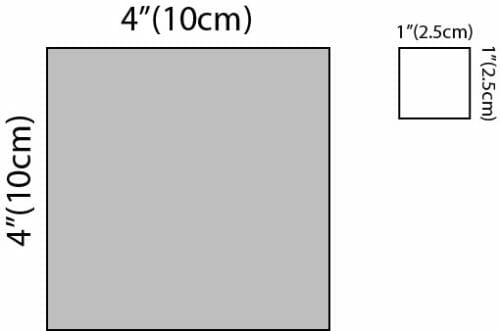

Add the rest of the squares.
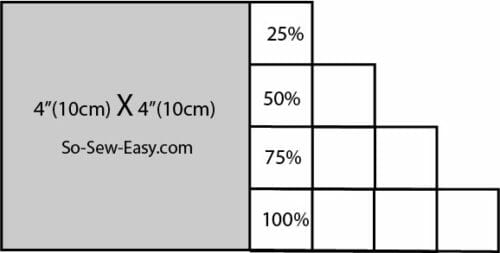

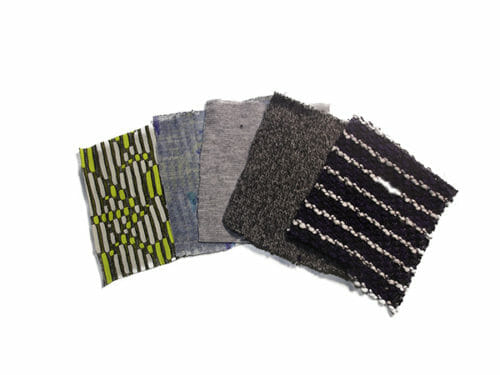

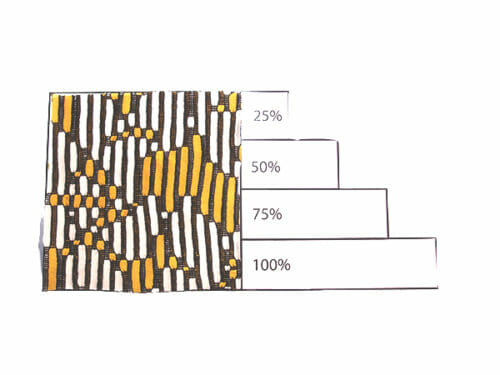

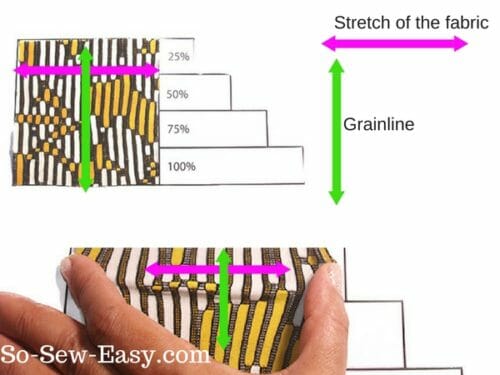

Now cut a square of the fabric lengthwise 4″ (10cm) X 4″ (10cm) that you want to test.Place the swatch on the square 4″(10cm) X 4″ (10cm).Using your fingers, stretch the fabric until you feel some resistance in the fabric weave, but the pattern does not distort.
The fabric on top is a Jacquard Knit and it stretches comfortably to 25%. I have used this fabric to make the culottes pants without a zipper.
Using the Results of Your Knit Fabric Stretch Test
I will be using the culottes pants pattern for an example. These culottes are fitted at the lower hips. It has a flare at the hips to accommodate a large bottom. There is no zipper on these pants. The stretch of the fabric allows me to design them like that. I am counting on the 25% stretch on each side to be able to hold the pants up.
- Stretch of fabric: The fabric I used has a 25% stretchability.
- The fit of the design: The culottes pattern pants are fitted on the waist and hips but flare slightly from the thighs.
- The finished measurements: The finished measurements on a pattern will let you know more accurately whether a size will fit on your body the way the picture of a garment describes it. It also determines how much ease is on a garment. The ease of the garment is determined by the minimum amount a pattern need to fit on the body plus the design of a garment.
- Your body measurements: Knowing your body measurements to compare with the pattern sizing and finished measurements.
How much fabric stretches will help you decided whether a fabric will be suitable for a particular pattern.
I am well aware that this tutorial is not for the beginner sewist, but for those of you who are a little more experienced would like to explore fabrics and create a wardrobe that is well fitted and more importantly uses the fabrics that are already in your stash.
Join me next time where I will be explaining in detail, sizing, and why it changes from label to label and country to country.
Until Next Time!








If I am in doubt about how a knit garment will fit, I cut the pieces out with 1″ seams. This gives me some room to let the seams out if the garment is just a bit too snug.
what about stretch test for headbands wht stretch number is acceptable
This is important stuff. Thank you for sharing. Everyone should be paying attention.